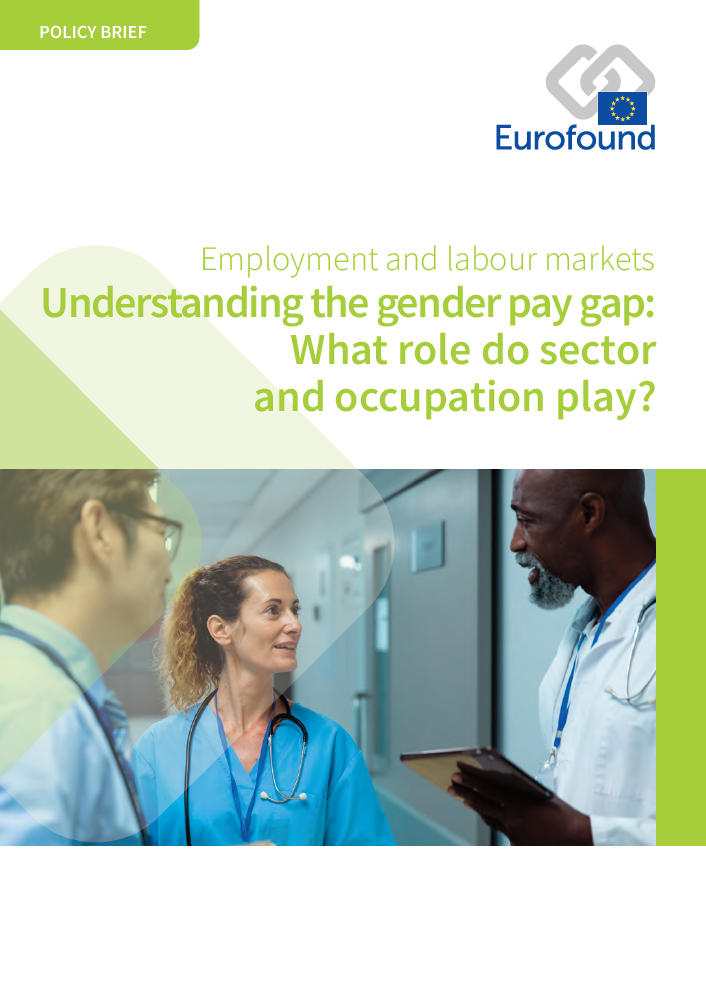
Despite the increasing participation of women in the labour market and a higher share of women than men being hired into well-paid jobs in recent years, a gender pay gap exists across all EU Member States. Pay differentials between women and men have been shown to be significantly influenced by the economic sector where people work and the occupation they hold.
This policy brief examines these dimensions. It also identifies how much these and other factors contribute to gender disparities in pay. The analysis finds that, of the observable factors examined, the greater likelihood of women working in lower-paying sectors and working part-time are the most important contributors to the gender pay gap. Nevertheless, around two-thirds of the gap in the EU remains unexplained by individual and employment-related factors typically analysed, suggesting that other factors not captured by survey wage data account for the rest of it.
Key findings
In 2019, the average hourly wage of women in the EU was 14% lower than that of men. Across the Member States, the gender pay gap was widest in Austria, Estonia, Germany and Latvia at around 20% and narrowest in Italy, Luxembourg and Romania at less than 5%.
Although women outperform men in educational attainment, this remains largely unrewarded in terms of higher pay. Women’s high educational achievement is, however, preventing an even larger pay gap across nearly all Member States.
The EU gender pay gap is larger among higher earners, highly educated employees and those with privileged labour market status related to age, job tenure, contractual arrangement and supervisory responsibilities. The proposed EU directive to introduce binding pay-transparency measures and enforcement mechanisms across the EU will aim to address opaque pay differences in well-paid jobs, in particular, where the gender pay gap is largest and where policy-based improvements may, as a result, have the greatest impact.
To help women avoid the pay penalty of working part-time and ensure they have the opportunity to earn more, it is critical to remove the barriers to full-time employment such as availability and affordability of care services and the rebalancing of paid and unpaid work between men and women. Caring and family responsibilities are the main reasons that women are employed part-time rather than full-time.
The persistence of gender segregation across sectors, occupations and jobs highlights the urgent need to encourage young men and young women to engage in sectors and occupations identified with the other gender, via education and training systems and other incentives.
The policy brief contains the following table and figures.
- Table 1: Gender pay gap (%), by job–wage quintiles, EU Member States, 2018
- Figure 1: Change in gender pay gaps (%), EU and Member States, 2010–2019
- Figure 2: Gender pay gaps and female employment rates (%), Member States, 2019
- Figure 3: Gender pay gap (%) and average wages by sector, EU, 2018
- Figure 4: Share of employees (%) and wage levels in selected occupations in the construction sector, EU, 2018
- Figure 5: Share of employees (%) and wage levels in selected occupations in the financial services sector, EU, 2018
- Figure 6: Share of employees (%) and wage levels in selected occupations in the health sector, EU, 2018
- Figure 7: Gender pay gap (%) and average wages, by occupation, EU, 2018
- Figure 8: Gender pay gap (%), by age and educational attainment, EU, 2018
- Figure 9: Gender pay gap (%), by work-related factors, EU, 2018
- Figure 10: Breakdown of the gender pay gap into explained and unexplained parts (%), EU and Member States, 2018
- Figure 11: Breakdown of the gender pay gap into factors contributing to the explained part (%), EU and six Member States, 2018
- Number of pages
-
28
- Reference nº
-
EF21039
- ISBN
-
978-92-897-2227-8
- Catalogue nº
-
TJ-AR-21-006-EN-N
- DOI
-
10.2806/939946
- Permalink
Cite this publication
Eurofound (2021), Understanding the gender pay gap: What role do sector and occupation play? European Jobs Monitor series, Publications Office of the European Union, Luxembourg.
